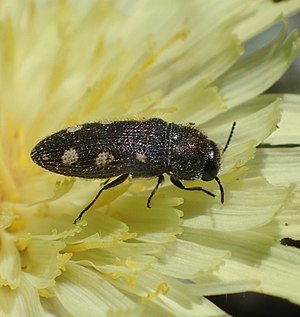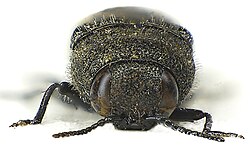Acmaeodera bipunctata
| Acmaeodera bipunctata | ||||||||||||
|---|---|---|---|---|---|---|---|---|---|---|---|---|

Acmaeodera bipunctata |
||||||||||||
| Systematics | ||||||||||||
|
||||||||||||
| Scientific name | ||||||||||||
| Acmaeodera bipunctata | ||||||||||||
| ( Olivier , 1790) |
Acmaeodera bipunctata is a beetle from the family of the jewel beetle and the subfamily Polycestinae . The genus Acmaeodera is represented in Europe with 25 species, which are divided into three sub-genera. Acmaeodera bipunctata belongs to the subgenus Palaeotethya , which is represented by four species in Europe. The species Acmaeodera bipunctata occurs in Europe in six subspecies.
Notes on the name
The beetle was first described by Olivier in 1790 under the name Buprestis bipunctata . The Latin and French description was made this year under the same wording both in the 2nd volume of the Entomologie ou Histoire Naturelle des Insectes and in the 5th volume of the Encyclopedie methodique - Histoire Naturelle des Insectes. The Encyclopledie is given as the source in Entomology , in the Encyclopedia , however, reference is made to the images of the beetle belonging to entomology . In neither of Olivier's two descriptions is the beetle name identified as a new species by an addition.
The Latin short description of the beetle begins with the words elytris serratis striatis nigris puncto flavo ( Latin with jagged, striped black elytra with a yellow dot ). This explains the species name bipunctata (Latin "with two dots", one on each wing cover). The table belonging to the description actually shows two copies with two dots. However, the beetle usually has six or more points. The synonym Acmaeodera sexpustulata (Latin "with six spots") does justice to this fact . In his description of the beetle, Spinola notes that the name bipunctata does not apply to the majority of individuals, but only to one variant, and that he therefore named the beetle after the entomologist from whom it received the beetle ( fr. le nom de bipunctata ne convenant pas à la plupart des individus de cette espèce j'ai cru pouvoir lui assigner un autre nom, qui ne disconviendra à aucune variété et je l'ai didié au naturaliste qui me l'a donnée ). He calls the beetle Acmaeodera Vaillant . Both descriptions refer to the nominate form Acmaeodera bipunctata bipunctata . Acmaeodera bipunctata senex , which is now a subspecies, was described in 1891 as the new species Buprestis senex . Lat. "Senex" means "old" and is used as a name for very hairy insects.
The generic name Acmaeodera goes back to Eschscholtz in 1829. He is from old gr. ακμαίος "akmāīos" for "strong" and δέρη "dére" for "neck" derived. Eschscholtz distinguishes the genus from similar genera by the pronotum that is cut off at the back .
The name of the subgenus Palaeotethya was only introduced by Volkovitsh in 1979. Volkovitsh does not explain the name.
In addition to the synonyms vaillant , senex and sexpustulata already mentioned , there are numerous other synonyms for the individual subspecies, which underlines the breadth of variation of the beetle.
  
|
| Different views |
Characteristics of the beetle
The beetle is 4.7 to 6.7 millimeters long. It belongs to the more cylindrically built species within the genus. When viewed from the side, it appears to be fairly evenly slightly arched, and from the front it appears conspicuously rectangular because of the concise shoulders. The beetle is dark bronze, the wing covers are about the same color with white or yellow spots. The hair consists of protruding white and brown hairs, which are directed a little forward on the head and pronotum and backward on the elytra and are shorter.
The head is lowered perpendicular to the body axis. It is pulled back into the pronotum up to the large, sideways eyes. The eleven-limbed antennae are sawed from the fourth limb and turned between the eyes. The head and pronotum are dense and relatively roughly dotted.
The pronotum is about twice as wide as it is long. Its base is somewhat narrower than the base of the wing-coverts, the sides narrowing towards the front relatively late and little. A flat longitudinal impression is quite wide at the back, but becomes increasingly indistinct and disappears towards the front. The pronotum has no lateral protuberances. The posterior angles are pointed, slightly curved downwards and visible from above. The front angles are deeper, blunt, not very clearly developed and not visible from above. A side edge is formed only near the base. The base of the pronotum, typical of the genera Acmaeodera and Acmaeoderella , is briefly fluted lengthways.
One label is missing.
The elytra are approximately parallel in the first two thirds, the end rounded. A finely corrugated bulge is formed at the base, and a matt and finely dotted elevation in the area of the shoulders, the callus humeralis. Elongated points form even, recessed longitudinal rows. The intervals in between are about the same width. They are fine and irregularly punctured, the puncture is quite dense and sometimes confluent, then the area appears rough. The wing cover seam is inconspicuous. The lateral edge of the wing covers swings upwards a little in the front area, but it is not outlined. In the rear area, the edge is finely indented.
The elytra are dark brown with white or yellow spots that vary greatly in number, shape and arrangement. They are more or less round, but they can also be split up or melt together. As a result, there is overlap with the drawing of related beetles, in particular there is a risk of confusion with Acmaeoderella flavofasciata . The similar species of the genus Acmaeoderella , however, have a striking white scale on the underside of the body, which Acmaeodera lacks.
Genital morphologically, the species of the bipunctata group have a tubular ovipositor in the female sex . In the male sex, the penis has a narrow sclerotized area on the dorsal side.
The legs are the same color as the body. All tarsi are five-part.
biology
The beetle is found in Greece in the pine forest of the coast and in the Phrygana . The larvae develop in various coniferous trees ( fir , pine , cedar , juniper , thuja ), but also in the fig tree . The beetles can be found on yellow flowers from April to July.
Occurrence
The species is counted among the holomediterranean species that can be found almost around the entire Mediterranean. Geographical subspecies have emerged. The nominate form Acmaeodera bipunctata bipunctata can be found in the west ( Austria , Germany , Portugal , Spain , Italy and northwest Africa), the subspecies senex in the east ( Albania , Bosnia and Herzegovina , Bulgaria , Hungary , Greece , Crete , European Turkey and the Middle East ). The subspecies romanoi occurs only in Sicily , the subspecies guillebeaui only on Cyprus , the subspecies obenbergeriana only on Corsica and the subspecies plagiana only on the Canary Islands .
Individual evidence
- ↑ Fauna Europaea systematics and distribution of Acmaeodera bipunctata , accessed on September 1, 2017
- ↑ M. Olivier in Encyclopedie Methodique - Histoire Naturelle des Insectes , Volume 5 Paris 1790 p. 236: 228
- ↑ M. Olivier: Entomologie ou Histoire Naturelle des Insectes 2nd volume Paris 1790 not paged through
- ↑ M. Olivier: Entomologie ou Histoire Naturelle des Insectes 7th volume, tables for volumes 1 to 6 Fig. 56a, b
- ^ Francis de La Porte de Castelnau , H. Gory: Histoire naturelle et iconographie des insectes coléoptères Vol. 1 Paris 1837 not fully paginated, Acmaeodera bipunctata as Acmaeodera sexpustulata p. 12
- ↑ a b Maximilien Spinola: Essai sur les espèces des genres Stéraspis et Acmaeodera, Famille des Buprestides, ordre des Coléoptères in Annales de la Société Entomologique de France Vol. 7. Paris 1838 p. 303 ff Species description p. 370 as Acmaeodera Vaillant and identification table as a foldout
- ↑ Elzéar Abeille de Perrin: Contribution aux Buprestides paléarctiques in Revue d'Entomologie Volume X, 1891 p. 279 as Acmaeodera senex
- ^ Sigmund Schenkling: Nomenclator coleopterologicus 2nd edition, Jena 1922
- ↑ Friedrich Eschscholtz: Zoological Atlas 1. Issue Berlin 1829 P. 9 in the Google book search
- ↑ a b М. Г. Волкович (MG Volkovitsh): Оьэор палеарктических грурр златок трибы Acmaeoderini (Coleoptera, Buprestidae) (Revision of Palaearctic groups of the tribe Acmaeoderini (Coleoptera, Buprestidae)) in ЭНТОМОЛОГИЧЕСКОЕ ОБОЗРЕНИЕ (Revue d'Entomology de l'USSR) LVIII, 2, 1979 S 343 or English translation by Research gate
- ↑ synonyms for insecta.pro , synonyms for zoographia Germaniae
- ↑ Mark G. Volkovitsh, Vladimir Sakalian, Georgi Georgiev: A checklist and a key to the taxa of the subfamily Polycestinae Lacordaire, 1857 (Coleoptera: Buprestidae) in Bulgaria in Acta Zoologica Bulgaria 67 (4), 2015: 471-478, p 476
- ↑ H.Mühle, P. Brandl, M. Niehuis: Catalogus Faunae Graeciae; Coleoptera: Buprestidae Printed in Germany by Georg Rößle Augsburg 2000 p. 61
- ↑ Fauna Europaea systematics and distribution of Acmaeodera bipunctata bipunctata , accessed on September 3, 2017
- ↑ Fauna Europaea systematics and distribution of Acmaeodera bipunctata senex , accessed on September 3, 2017
- ↑ Fauna Europaea systematics and distribution of Acmaeodera bipunctata romanoi , accessed on September 3, 2017
- ↑ Fauna Europaea systematics and distribution of Acmaeodera bipunctata guillebeaui , accessed on September 3, 2017
- ↑ Fauna Europaea systematics and distribution of Acmaeodera bipunctata obenbergeriana , accessed on September 3, 2017
- ↑ Fauna Europaea systematics and distribution of Acmaeodera bipunctata plagiata , accessed on September 3, 2017